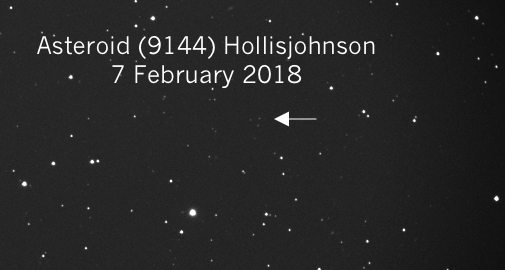D850 DSLR Astrophotography:
Asteroid (9144) Hollisjohnson, Mag +17.5
Posted: 8 February 2018
|
Open: Wednesday, 7 February 2018, 1828 MST Temperature: 74°F |
Session: 1198 Conditions: Clear |
Equipment Used:
12" f/8 LX600 w/StarLock
2" 24mm UWA eyepiece
2" 2X PowerMate
Focal Reducer
Camera:
D850 DSLR
1846 MST: LX600 ON, StarLock OFF, High Precision OFF.
1847 MST: slewed to NGC2392 (Eskimo Nebula). It was a nice view even against the still somewhat bright sky, 102X. SYNCed the AutoStar II on its location in anticipation of imaging it after the end of Astronomical Twilight (1926 MST).
1919 MST: slewed to the star Procyon, which would be the DSLR focus star. Mounted the D850 DSLR at prime focus + 2X PowerMate. Focused on Procyon. Slewed back to NGC2392. 1932 MST: StarLock ON. Attempted to image the Eskimo Nebula but seeing was not good enough for the magnification I was using. Gave up. 1940 MST: StarLock OFF. Removed the camera from the telescope.
2000 MST: slewed to the star Pollux, which would be my focus star for my next imaging target: Asteroid (9144) Hollisjohnson, Magnitude +17.5. I began waiting for the asteroid to get higher in the sky. Mounted the D850 DSLR at prime focus + focal reducer.
2024 MST: Wi-Fi ON. Used the iPhone 8 Plus and the iOS app SkySafari 6 Pro to GOTO Asteroid (9144) Hollisjohnson. 2025 MST: StarLock ON.
2030 MST: I took a StarLock autoguided, 5 minute, ISO 6400, White Balance 3570K, exposure. 2042 MST: Wi-Fi OFF. 2130 MST: did another similar image. 2142 MST: StarLock OFF.
During post-processing of the two images I used a "blink" technique to identify the moving asteroid over the 1 hour interval. I was able to image this very faint (Mag. +17.5) asteroid named after Dr. Hollis Johnson, who was an astronomy professor at Indiana University when I was an Astrophysics undergraduate student there 1966-70. Here is a photograph I took of Dr. Johnson when I visited IU in 2000:

On the blackboard behind Dr. Johnson you can see my URL (www.weasner.com)!
I was thrilled to be able to capture Asteroid (9144) Hollisjohnson, as seen in the following photo and animated image (merge of the two photos separated by one hour). The images were cropped from the full-frame versions to just show the asteroid.


FYI: I previously imaged Asteroid (1761) Edmondson (Mag. +17.2) on 11 and 12 January 2018. Dr. Frank Edmondson was the Chairman of the Indiana University Astronomy Department when I was an undergraduate student and working on the IU Asteroid Program.
2153 MST: viewed the galaxies M95 and M96, 102X. They were too low to image. Also viewed the Leo Triplet of Galaxies (M65, M66, and NGC3628), 102X, also low in the sky, but still nice views. Lastly viewed M51 (Whirlpool Galaxy), 102X, low in the sky but a very good view.
2200 MST: LX600 OFF.
|
Close: Wednesday, 7 February 2018, 2209 MST Temperature: 53°F |
Session Length: 3h 41m Conditions: Clear |
Comments are welcome using Email. Twitter users can use the button below to tweet this report to their followers. Thanks.
Cassiopeia Observatory Home Page
Copyright ©2018 Michael L. Weasner / mweasner@me.com
URL = http://www.weasner.com/co/Reports/2018/02/08/index.html
